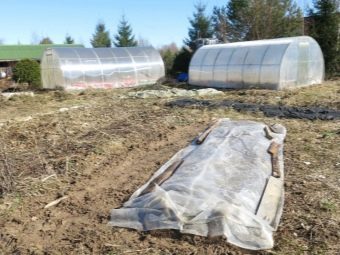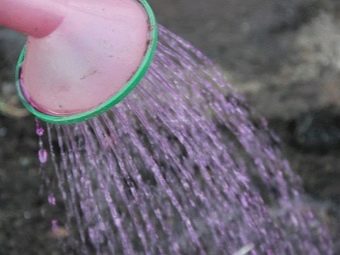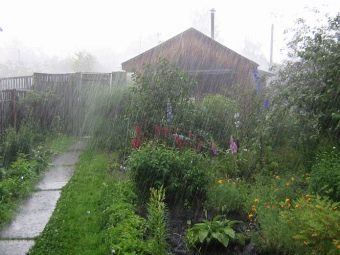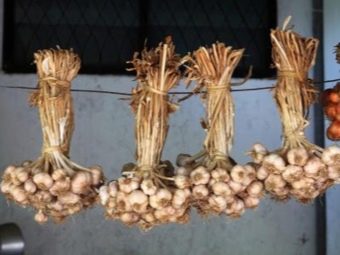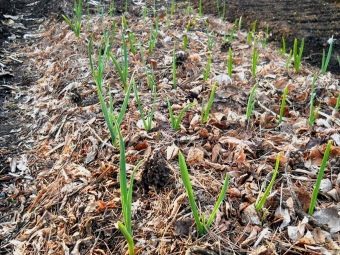How often to water the garlic in the open field?
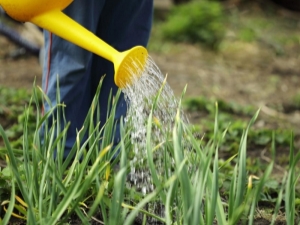
Garlic is a common vegetable used in various spheres of human activity.It is used to improve the flavor and taste of dishes, the healing properties of garlic are known in medicine and help to cure many diseases, and are also used to prevent their appearance. Experienced gardeners use garlic dressing as a natural fungicide to add to their plots, which allows to feed and fertilize the soil.
Grow this culture does not amount to hassle. But you need to know certain rules that will help get a big harvest. The main of them is timely watering. This is due to the fact that the root system of this vegetable is underdeveloped, and therefore it will require special care.
Features of culture
Garlic loves watering, especially if planted in open ground. To make it large, it is recommended to water it abundantly. Garlic planted for the winter, that is, winter, is not so demanding for irrigation, as it is constantly under the film and in the ground, and therefore receives enough nutrients from it at the time of the growing season.
Initially, before planting a crop for the winter, you should not water it abundantly. It is required to do this in a small amount, adding water and covering it securely with a film. In spring, garlic will be fueled by melting snow and rain. When it gets warmer on the street, garlic can be opened for a day, so as not to be affected by frosts. And also at this time a gradual sprinkling is carried out.
This culture loves moisture, and if the soil at the place of its growth is dry, the feathers will become tasteless and white. The lack of moisture also negatively affects the other qualities of garlic. It is especially important to give garlic a good irrigation at the time of growth, when it forms a tooth. At this point, you can also add additional fertilizer to improve conditions and enrich the soil with useful elements.
Regardless of which region the crop is grown in, it must be supplied with a sufficient amount of moisture. The taste, its appearance and growth are also influenced by the climate, especially natural precipitation. Moisture is a medicine for this crop, and therefore watering should be carried out in compliance with the rules in order to get a good and big harvest.
The main need for moisture comes at the time when it will be planted in the soil, so that the first healthy shoots appear. Humidity should be at this moment not less than 80%, and therefore watering is attached during this period of great importance. When the first shoots appear, and this will happen one to two weeks after planting, watering should be done every 4-6 days. If the weather in the region is hot, then more often.
When rainfall is constantly falling outside, no additional water will be needed for the plants. It will be necessary to increase the intensity of watering at the moment when the plant releases feathers and its teeth are formed. Further moistening is carried out as the soil dries out. Experienced gardeners recommend watering at the rate of 10-11 liters of water per square meter. m of land.
After each event for watering need to inspect the beds. If the moisture washed the bulbs out of the ground, then they should be sprinkled. The same recommendations should be followed during the rains. When a plant is forming and growing, the intensity of watering gradually stops.
To keep the product longer, 20-25 days before the start of its collection should be completely stopped watering. In this case, he will not accumulate moisture in the teeth, and he will be able to lie longer and survive. If garlic is needed for processing raw right after harvesting, irrigation should be stopped 4-5 days before that moment.
If the garlic does not have enough water or there is an excess of it, this is manifested in its appearance. The feathers in this case become bluish and gradually fold.
Since the culture has a not too developed system of roots, watering should be carefully monitored, especially during the growing season and in the first days after this during the arid summer.The moisture level is determined by some signs, the main of them is the lightening of the tops. If the leaves turn yellow, it also indicates a shortage or large amount of moisture in the soil. In some cases, such a manifestation may indicate the presence of pests in the soil.
When growing this plant, it is worth remembering that moisture and its amount affects the quality and size of the bulbs. To grow large, juicy and tasty, it is required on the site where the crop is planted, periodically produce fertilizer soil. This will have a positive effect not only on the type of plant, but also on yield.
To moisten the soil using ordinary water, which is added a little salt. To do this, take a bucket of water and divorce it 150-200 g of sodium chloride. Such a salt solution is poured on a bed of garlic after it has sprouted, when 4-5 leaves have already formed on the stems.
During irrigation with salted water, the ground is also enriched with nutrients on the ground. Salt solution can destroy some types of parasites.
If the arrows do not appear for a long time after the deadline, the soil should be additionally irrigated with a solution of potassium permanganate in a low concentration. This is done in early spring 2-3 days after the expected shoot.
Spring and winter garlic are also watered in combination with the addition of fertilizers to the soil. For them use top dressing as organic additives or mineral. These types of crops are usually irrigated with liquid solutions that positively affect both the state of the plant and the soil.
Ways
This culture will require enough moisture during growth, especially during the growing season. According to the norms, the specialists determined that garlic needs about 3000 m3 / ha of moisture. Only with the observance of such rules can one get a large and good harvest, which will be stored for a long time and differ in quality. In industry, as well as in the household, it uses different methods of irrigation for growing.
Among them are:
- drip;
- sprinkling;
- manual.
If the site is small, then the latter method is usually used, where the watering of garlic is based on the evening and morning. In the daytime, watering can be avoided, since burns can appear on the plant with an abundance of moisture and heat.
But it is also important to navigate before watering on weather factors. According to the norms of irrigation, 10-11 liters of water per square meter should be given to the crop. m once every 10 days. Such manipulations should be carried out at an average temperature of +15 degrees Celsius. If the weather is dry, the break should be halved. During unstable temperatures or the rainy season, watering stops altogether.
Drip irrigation
The basis of this technique is the use of special equipment for wetting the site. Irrigation is carried out using tubes with dispensers, which are located on the plot area.
If preference is given to this method of irrigation, then you need to know that every 2-3 years you need to completely change all the elements in the spray unit, as they can become clogged by insects or soil, and therefore the irrigation system will not work properly.
Sprinkling
This method makes it possible to spray moisture from plants in the form of microdroplets. Thanks to this method, it is possible to irrigate the plot qualitatively and evenly and to control the soil moisture on it. Advantages of the method of making moisture - the ability to add pesticides to the soil along with moisture.
Also, this system has certain disadvantages, among which are the main ones:
- high cost of equipment;
- watering quality depends on the strength of the wind.
When working with this culture, you need to know certain rules, as well as follow them. When watering is done, the moisture should penetrate into the soil to a depth of 30-40 cm. Each watering is completed by loosening the soil in the area so that the moisture penetrates better into the soil.
In some cases, salt water is used, which is added to the site to protect the garlic from pests, as well as deoxidize the soil. Saline watering is done at the time of sprout, when they already have 4-5 pieces. For irrigation, use the usual salt, which is diluted in the amount of 200 g per bucket of water.
Experienced gardeners say that you should not add too much chlorine and sodium to the soil, since a large amount of salt in it can slow down the growth of development. As well as the salt mixture is dangerous for the soil. It can destroy its structure and provoke the removal of microelements, which are located in the upper nutrient layer. Therefore, when adding salt, it is necessary to carefully monitor the dosage and, if necessary, dilute the solution with additional water to reduce its concentration.
What does the frequency depend on?
In each case, the frequency of irrigation is determined depending on the region of crop growth, as well as weather conditions. When the weather is dry, you need plenty of watering the land for garlic. At this time, approximately 15 liters of water per square meter are used. m
If the weather is normal, then garlic culture is watered with a liquid volume of less than 3 times. When raining garlic does not need to moisten the soil. If the rains are poured heavily on the bed, then experienced gardeners make grooves on the site for diverting water.
The lack of moisture will be noticeable by the general condition of the plant, as well as by the white color of the stems. In that case, if the tips of the leaves begin to dry, the amount of moisture should be increased, as well as the frequency of watering should be increased.
The main amount of moisture required by the plant in the spring after germination. In summer, the frequency of watering is determined depending on the temperature. It will be right to initially water the garlic immediately after planting in May. Winter garlic is often not required to be watered, as it will take the necessary moisture from the ground under the film. Watering is necessarily warm water. Cold is not recommended.
When to stop?
When the season ends, and all the problems with watering and caring for the crop is over, there comes a time of harvest. Experienced gardeners know how to deal with irrigation. They recommend before harvesting to abandon watering completely, but this should be done in certain periods, which depend on the purpose of growing garlic.
When you need to store the harvest for a long time after harvesting, watering is stopped 20 days before the start of the harvest. If garlic is processed fresh, then watering should stop one week before the start of its collection, and the arrows are not removed from the plant.
In each case, the timing of irrigation of garlic should be finished depending on the region where it is grown, and the weather conditions there. It is important to pay attention to natural factors, the quality of the soil and other moments. The greatest amount of moisture the plant will need in June, when the activity of the sun is the largest. After that, they stop pouring it abundantly and add moisture to the soil as it dries.
Although the cultivation of this crop is quite simple, anyone, even an inexperienced gardener, can handle this issue, but there are certain rules that are important to get good yields. Non-observance of such moments can negate all the efforts that were made at the time of planting and caring for the culture. It should be noted that excessive guardianship over garlic will be considered superfluous. Therefore, the degree between the holding of various events should be a certain line.
Among the most common mistakes that inexperienced gardeners make are some points.
- It is not recommended to plant the garlic constantly in the same place, as this may lead to a decrease in yield. It is recommended that the intervals between planting culture at a certain site in 3-4 years.
- For a good harvest, it is recommended to choose the beds that are not shaded by trees or shrubs. When a plant receives little light, its vegetation will also be bad.
- It is recommended to feed the soil at the landing site well. This is usually done in spring or autumn, when it is prepared for wintering or planting.
- It is important to use nitrogen fertilizers in the correct proportions. Despite the fact that they are important and useful for the culture, but their excess may cause a decrease in the shelf life of garlic. Usually add them to the ground at the time of formation of garlic heads.
- Abundantly watered plants need at the initial stage, when the first shoots appear. Then the water rate gradually decreases, and then the watering stops completely. There are no specific recommendations on the timing of irrigation, since everything depends on the regions where the crop grows. It is also important to stop watering in time before harvesting garlic, depending on the purpose for which it is grown.
- Before planting, the material must be properly prepared and sorted. Dental teeth should be separated from each other without damaging the scales. This will help prevent it from rotting in the ground after landing.
- It is important to produce in time and harvest, as the delay may cause the decay of the cloves in the soil. After removing the garlic from the ground, it must be dried and prepared for wintering. This should be done in the sun with a slight wind.
As you can see, it is easy to grow garlic, but for this you need to make some effort and also take care of it in order to get a good harvest. To make it easier to navigate in all these moments, experienced gardeners create special schedules of activities that should be held on a mandatory basis. This makes it possible to provide the soil with nutrients in a timely manner, as well as to prevent plants from pests and various diseases.
Some gardeners use special tools for growing garlic, which help them to regulate the soil moisture in a timely manner, as well as determine the time for adding additional moisture to the soil. For this purpose, special devices are used, which are called moisture meters. They can be used to measure soil moisture.
If the humidity is at 70 percent or less, then garlic needs watering. If it is not possible to find such a device, then the method tested over the years is used. It does not require the use of any devices. For this, a lump of earth is taken in hand from a depth of 10 cm and compressed. After that, you need to open the palm and check the results. If there is moisture on the hand, the soil does not require additional feeding and moisture. If the hand remains dry, you need to make water.
In the region where there is a very dry summer, and there is no possibility to ensure an adequate and abundant supply of water to the site, mulching can be used, which will also help to retain enough moisture in the soil and prevent it from evaporating quickly from there. To do this, you can use sawdust, mowed or listen to the grass.
With such compositions, the area between the plants is covered, and then the top is filled with additional water. Mulching will not allow the development of weeds, and will also retain moisture in the soil. In such a simple way, you can reduce the number of irrigations and reduce the frequency of activities.
To get a good harvest, it is important to combine irrigation of garlic with fertilizer in the soil. Typically, this is used and mullein, diluted in water, but you can also purchase special tools in stores. It is recommended for the season to produce four such irrigation with fertilizer.
The first time you need to make fertilizer immediately after the sprouts. The second time is watering in 14 days using components from nitrogen.Usually at this moment the formation of bulbs occurs, and therefore it is recommended to add to the superphosphate solution. The third and fourth watering with the addition of fertilizers must be done by distributing the time evenly from the time of the last watering until the end of watering. In each case, the timing will vary, and the amount of fertilizer that needs to be applied to the soil will differ. It depends on the region of germination of the culture.
If you carefully examine all the information presented above, as well as to follow these recommendations, you can easily, without much effort and time or effort, cope with all the nuances and problems of growing this homely culture in home care.
See how to water garlic in the video below.





